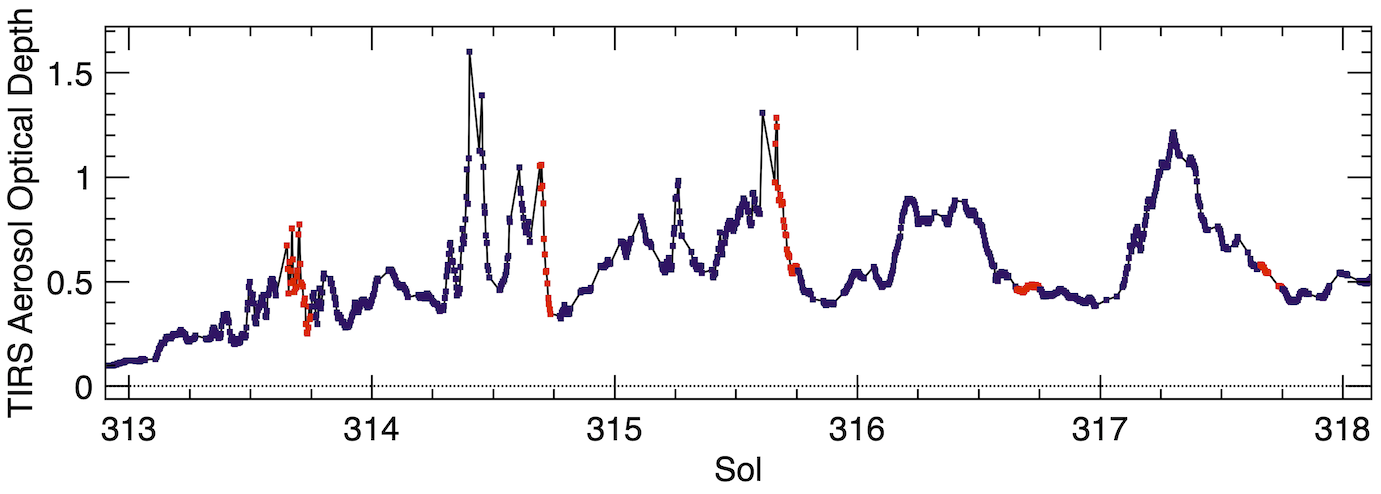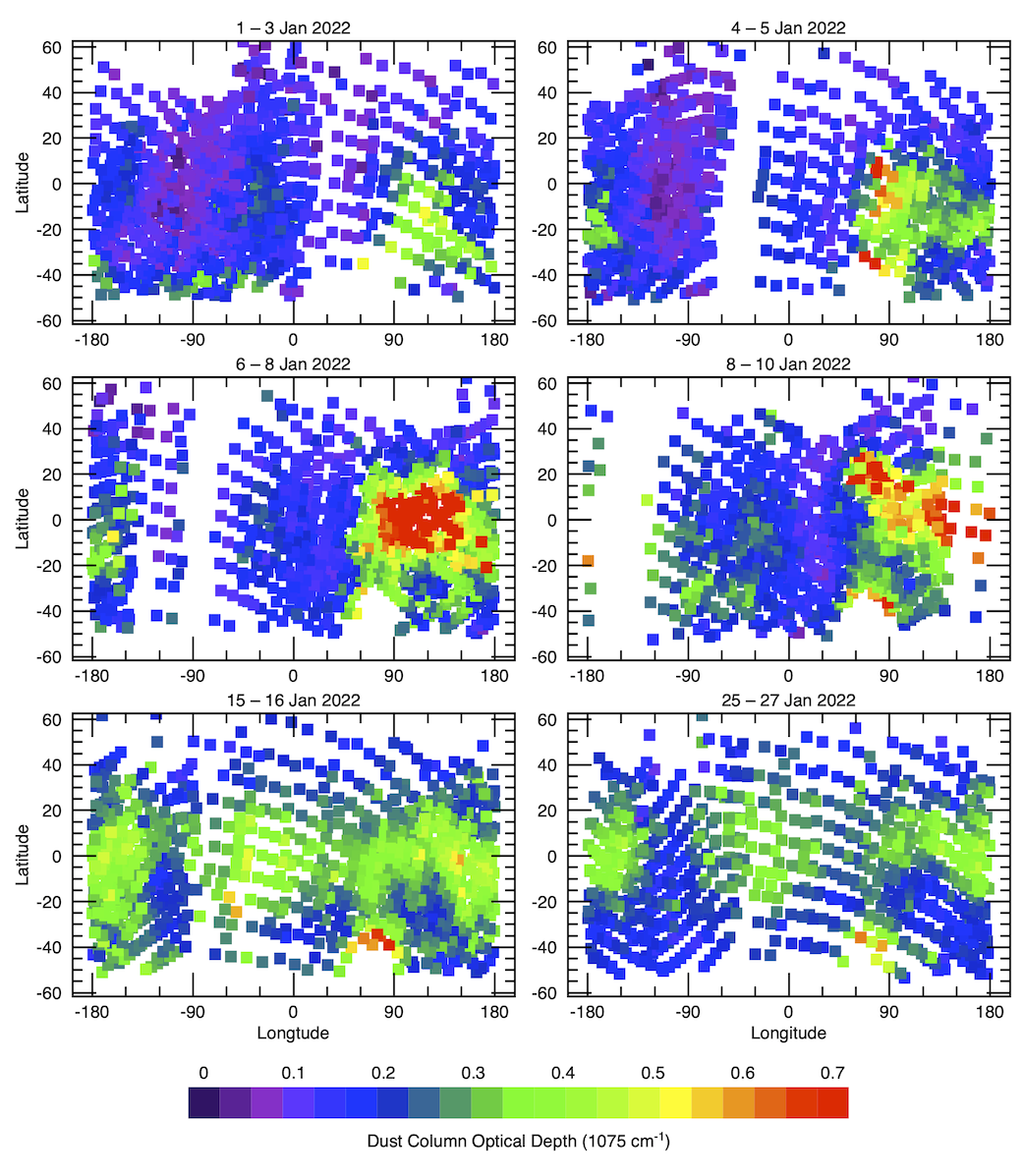The diurnal and seasonal variation of dust observed by the Perseverance rover and Emirates Mars Mission
- 1NASA Goddard Space Flight Center, Greenbelt, MD, United States of America (michael.d.smith@nasa.gov)
- 2Mohammed Bin Rashad Space Center, Dubai, United Arab Emirates
- 3Laboratory for Atmospheric and Space Physics, University of Colorado, Boulder, CO, United States of America
- 4Lunar and Planetary Institute, Houston, TX, United States of America
- 5Centro de Astrobiologia (INTA-CSIC), Madrid, Spain
- 6Northern Arizona University, Flagstaff, AZ, United States of America
- 7Space Science Institute, Boulder, CO, United States of America
- 8Arizona State University, Tempe, AZ, United States of America
- 9NASA Jet Propulsion Laboratory, Pasadena, CA, United States of America
Thermal infrared observations made from the surface of Mars by the Perseverance rover and from orbit by the Emirates Mars mission enable the retrieval of dust aerosol optical depth at all local times, both day and night. Observations from the rover are useful for characterizing the localized, short timescale changes in dust optical depth, particularly during dust storms, while observations from the orbiter and useful for identifying global trends and temporal variations on longer timescales, from diurnal to seasonal. Together, these two vantage points provide complementary information that helps to understand the variations of dust over different temporal and spatial scales.
1. Introduction
1.1 Perseverance TIRS data:
The Thermal InfraRed Sensor (TIRS) package on the Perseverance rover consists of five sensors used to characterize the upward and downward fluxes of visible and infrared radiation at the rover site (Rodriguez-Manfredi et al., 2021). Of interest here are the sensors TIRS IR1, which covers a broad portion of the thermal-infrared spectrum over the range 6–35 µm and TIRS IR2, which covers the CO2 band between 14.5 and 15.5 µm. Both sensors view upward at an elevation angle centered at 35° above the rover deck. As part of the MEDA suite of atmospheric sensors, TIRS observations are taken systematically throughout the sol at a frequency of 1 Hz. Observations in one-hour blocks are generally taken so that odd-numbered hours are covered on odd-numbered sols, while even-numbered hours are covered on even-numbered sols. In that way the entire 24-hour diurnal cycle is fully covered over a span of 2 sols. These observations are a part of the background baseline set for MEDA that runs essentially every day providing excellent diurnal and seasonal coverage.
We use a radiative transfer model to compute the expected TIRS IR1 and IR2 signal for a given aerosol optical depth and temperature profile. We can then perform the retrieval by varying the atmospheric temperatures and aerosol optical depth to match the values observed by TIRS. The radiative transfer model includes aerosol scattering using a 2-stream approximation (e.g., Smith et al., 2006) and treats absorption by CO2 gas using the correlated-k approximation (Lacis & Oinas, 1991).
1.2 Emirates Mars Mission EMIRS data:
EMIRS is a thermal infrared spectrometer that observes Mars at wavelengths between ~100 and 1600 cm-1 (~100 and 6 µm) at a spectral resolution of 5 or 10 cm-1 (Edwards et al., 2021). From its 55-hour period orbit that varies between 20,000 and 43,000 km altitude, EMIRS raster scans the disk of Mars ~20 times during each orbit to provide a global, synoptic view of Mars that samples all local times, both day and night (Amiri et al., 2021). Over the course of approximately 4 orbits (or 10 days), sufficient observations are taken to provide a broad sampling of all local times at nearly all latitudes and longitudes. The typical footprint size is ~100–300 km, which is consistent with modern global circulation models and is sufficient to provide a detailed global view of the current climate state.
We follow the constrained linear inversion algorithm of Conrath et al. (2000) and Smith et al. (2006) to retrieve atmospheric state parameters that best match the observed spectra of Mars from EMIRS. The radiative transfer model includes a discrete ordinates treatment of multiple scattering (e.g., Goody & Yung, 1989; Thomas & Stamnes, 1999) to accurately model dust and water ice cloud aerosols, and it accounts for the absorptions from CO2 and water vapor gases using the HITRAN database (Gordon et al., 2022) and the correlated-k approximation (Lacis & Oinas, 1991).
Given that the spectral signatures of gases and aerosols are relatively well separated in the spectral range observed by EMIRS, the retrieval is performed sequentially for the atmospheric temperature profile, the column optical depths of dust and water ice aerosol, and the column abundance of water vapor. This sequence can be iterated to obtain a self-consistent solution.
2. Results
Figure 1 shows an example of Perseverance/TIRS retrieval of the complex time history of dust optical depth during a regional dust storm that occurred during January 2022. Here, the sol numbers label midnight LTST. During the active period of this dust event between sols 313 and 317 (5–9 January 2022, Ls=153°–156°) there were numerous spikes in aerosol optical depth with several exceeding unity (at 9 µm). These spikes in aerosol (dust) optical depth occurred preferentially during the day but appear equally in both the morning and the afternoon. Retrievals of dust optical depth outside the dust storm period showed a combination of variations on many timescales from very short (minutes), to diurnal, to the overall seasonal trend.

Figure 1. The detailed time history of dust optical depth retrieved from Perseverance TIRS observations during the January 2022 regional dust storm. Local variations on short timescales are apparent.
The January 2022 regional dust storm was also observed by the Emirates Mars Mission/EMIRS instrument. Figure 2 shows a global-scale view of the initiation, growth, and decay of the storm as observed from orbit. Over the course of several days localized dust activity intensified and spread equatorward becoming a regional storm. New dust lifting quickly diminished and the dust was carried by the general circulation to all longitudes before slowly settling out of the atmosphere. These dust retrievals provide global context to those from the rover.

Figure 2. The time history of the global aerosol dust optical depth retrieved from EMIRS observations during the January 2022 regional dust storm. A global view of the evolution of dust is possible from orbit.
References
Amiri, H.E. S. et al., 2021. Space Sci. Reviews, 218:4, doi:10.1007/s11214-021-00868-x.
Conrath, B.J. et al, 2000. J. Geophys. Res., 105, E4, 9509–9519.
Edwards, C.S. et al., 2021. Space Sci. Reviews, 217:77, doi:10.1007/s11214-021-00848-1.
Goody, R.M. & Yung, Y.L., 1989. Atmospheric Radiation: Theoretical Basis. Oxford Univ. Press.
Gordon, I.E., et al., 2022. JQSRT, 277, doi:10.1016/j.jqsrt.2021.107949.
Lacis, A.A. & Oinas, V., 1991. J. Geophys. Res., 96, 9027–9063.
Rodriguez-Manfredi, J.A. et al., 2021. Space Sci. Reviews, 217:48, doi:10.1007/s11214-021-00816-9.
Smith, M.D., et al., 2006. J. Geophys. Res., 111, E12S13, doi:10.1029/2006JE002770.
Thomas, G.E. & Stamnes, K., 1999. Radiative Transfer in the Atmosphere and Ocean, Cambridge Univ. Press.
How to cite: Smith, M., Badri, K., Atwood, S., Martínez, G., Sebastián, E., Apéstigue, V., Arruego, I., Toledo, D., Viúdez, D., Manfredi, J. A., Edwards, C., Smith, N., Wolfe, C., Wolff, M., Christensen, P., Anwar, S., Lemmon, M., AlTunaiji, E., and de la Torre, M.: The diurnal and seasonal variation of dust observed by the Perseverance rover and Emirates Mars Mission, Europlanet Science Congress 2022, Granada, Spain, 18–23 Sep 2022, EPSC2022-599, https://doi.org/10.5194/epsc2022-599, 2022.

